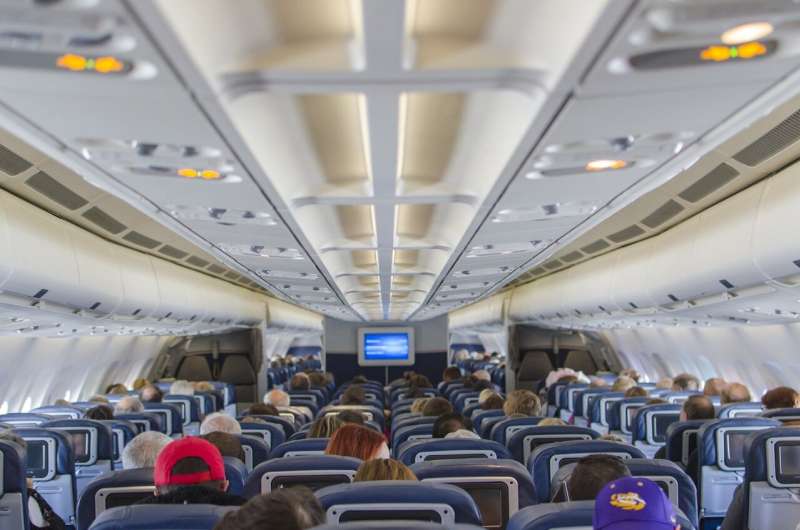
There is no evidence for the commonly held belief that nut allergens can be spread through aircraft ventilation systems, say allergy and aviation medicine specialists in an evidence review published in the Archives of Disease in Childhood.
Allergen residues on surfaces, such as tray tables, and seat-back video screens, pose the main risk—a risk that is likely heightened by the fast turnaround times deployed by many low-cost carriers, they suggest.
And allergic reactions to foods are around 10 to 100 times less common during flights than they are “on the ground,” they point out, although this could be due to passengers with food allergies taking more precautions when flying, they acknowledge.
Around 2–3% of children and 1–2% of adults in the UK have a food allergy, say the authors. And similar rates are observed in medium to high income countries. Food allergy is the most common cause of anaphylaxis, a potentially life threatening allergic reaction.
In a bid to dispel some of the misconceptions about the perceived risks posed to passengers with food allergies on commercial flights, the authors drew on the systematic review of the published evidence dating back to 1980, commissioned by the UK’s Civil Aviation Authority (CAA) in 2023.
With the notable exceptions of vapors from fish/seafood and exposure to occupational wheat flour, allergic reactions to aerosolized foods are rare, and rarely reproducible, say the authors.
While peanut allergens can be detected at very low levels in the air when shelling nuts, the dust settles quickly and can only be detected in very close proximity to the nuts, implying that very little dust circulates in the air.
What’s more, aircraft cabin ventilation systems are designed to circulate air across the aircraft, rather than along the cabin, so minimizing the potential for spreading passenger-generated contaminants through the cabin, explain the authors.
Air is completely exchanged every three to four minutes during a flight. This compares with every 10 minutes for hospitals and classrooms. In modern large commercial aircraft, around half of the air intake is recirculated air that has passed through particulate air filters which effectively remove dust, vapors, microbes, and capture aerosolized food particles at the same time. The other half comes from outside.
Food proteins are often “sticky,” and any unintentional exposure likely stems from surface contamination on seats, seat-back entertainment systems, and tray tables. This could be transferred from the hands either to food being eaten or directly to the mouth and/or face.
Cleaning these surfaces at the start of a flight with sanitizing wipes will minimize this risk, and is “particularly important, given the minimal cabin cleaning which often occurs in between flights, especially with low-cost carriers,” highlight the authors.
Allowing food-allergic passengers to pre-board may be helpful in this respect, say the authors, who note that the US Department of Transportation already requires airlines to allow passengers with nut allergies to do this.
But announcements requesting passengers not to consume nuts during the flight are unlikely to reduce the risk of in-flight reactions, and might provide false reassurance, they add.
While many passengers with food allergies prefer to bring their own food, where an in-flight meal service is provided, most airlines offer allergen-free options, if requested in advance.
And passengers at risk of food anaphylaxis should carry adrenaline [epinephrine] auto-injectors, such as an EpiPen in their hand luggage, as these aren’t always included in onboard medical kits, nor are cabin crew always allowed to use them, advise the authors.
“There is no evidence that peanut or tree nut allergens are spread through aircraft cabin ventilation systems. Rather, the main risks are due to either failure of dietary avoidance, or allergen residues on surfaces, which can then be transferred through touch—a situation exacerbated by the very short turnaround times with many low-cost carriers,” conclude the authors.
“Airlines should have clear policies relating to food allergies which are easily available from their websites or on request. These policies should be applied consistently by both ground staff and cabin crew, in order to provide reassurance to food-allergic passengers and their caregivers,” they add.
More information:
Flying with nut and other food allergies: unravelling fact from fiction, Archives of Disease in Childhood (2024). DOI: 10.1136/archdischild-2024-327848
Citation:
No evidence for belief that nut allergens spread through aircraft ventilation systems, say experts (2024, October 15)
retrieved 16 October 2024
from https://medicalxpress.com/news/2024-10-evidence-belief-nut-allergens-aircraft.html
This document is subject to copyright. Apart from any fair dealing for the purpose of private study or research, no
part may be reproduced without the written permission. The content is provided for information purposes only.




